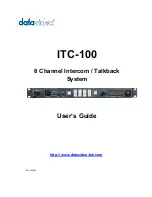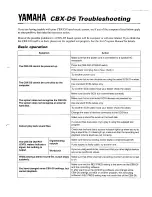
1-1
Section 1. Introduction
The SDM-SIO4 has four configurable serial RS232 ports which allow it to be connected to
intelligent serial sensors, display boards, printers or satellite links. It can also be used in
many other applications where the data is transferred in a serial fashion. This device is
designed to send data to and receive data from the sensors, and process it in parallel with
the datalogger’s own program sequence, thus making the complete datalogging system
faster and more efficient.
The SDM-SIO4 can handle the incoming and outgoing data in many different ways. It can
either send data in the same format as sent from the datalogger or it can be programmed
to send pre-stored data strings to the sensor. Combinations of data sent from the
datalogger and pre-stored strings can be sent, allowing complex formatted data to be sent.
For input, the SDM-SIO4 can transfer data in the same form as received from a sensor to
the datalogger, or it can be programmed to filter out critical data from a sensor and only
pass back the data the datalogger requires.
This manual assumes that you have a basic knowledge of the
terminology and theory of serial communications. For further
information please refer to one of the standard textbooks on this
subject.
1.1 What is the SDM-SIO4?
The SDM-SIO4 is a device that is connected to a datalogger through the
datalogger SDM port. The SDM port is specific to Campbell Scientific
dataloggers and acts as a high-speed data exchange mechanism. On some
dataloggers it is a dedicated port; on others it is implemented using control
ports C1, C2 and C3.
Figure 1-1, on the next page, is a Schematic Diagram giving an overview of the
functions of the SDM-SIO4. When used in conjunction with the following
sections of this manual, it may help you to understand how the SDM-SIO4
operates.
The datalogger program controls the sequence and timing of data exchange
with the sensors. However, unlike most other Campbell Scientific interfaces the
SDM-SIO4 can be configured in two ways:
1.
By inserting commands in the datalogger program
2.
By connecting a computer running a terminal emulation program to serial
port 1 on the SDM-SIO4. Pressing a switch on the SDM-SIO4 temporarily
switches this port to allow you to access a ‘command line’ (for entering
command strings in much the same way as entering commands at the DOS
prompt on a PC).
The ‘command line’ option allows you to store complex output strings and data
filters in the SDM-SIO4. This set-up information is stored in battery-backed,
NOTE
Summary of Contents for SDM-SIO4
Page 6: ...SDM SIO4 Table of Contents iv This is a blank page ...
Page 12: ...Section 1 Introduction 1 6 This is a blank page ...
Page 16: ...Section 2 Installation and Hardware Set Up 2 4 This is a blank page ...
Page 26: ...Section 3 Understanding How the SDM SIO4 Handles Data 3 10 This is a blank page ...
Page 32: ...Section 4 Programming the SDM SIO4 4 6 This is a blank page ...
Page 62: ...Section 5 Programming the Datalogger 5 30 This is a blank page ...
Page 76: ...This is a blank page ...
Page 81: ...This is a blank page ...








































